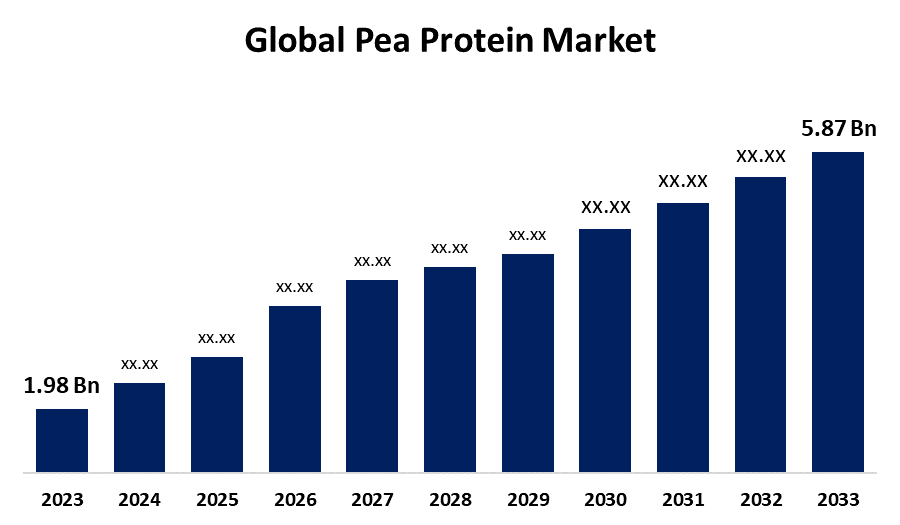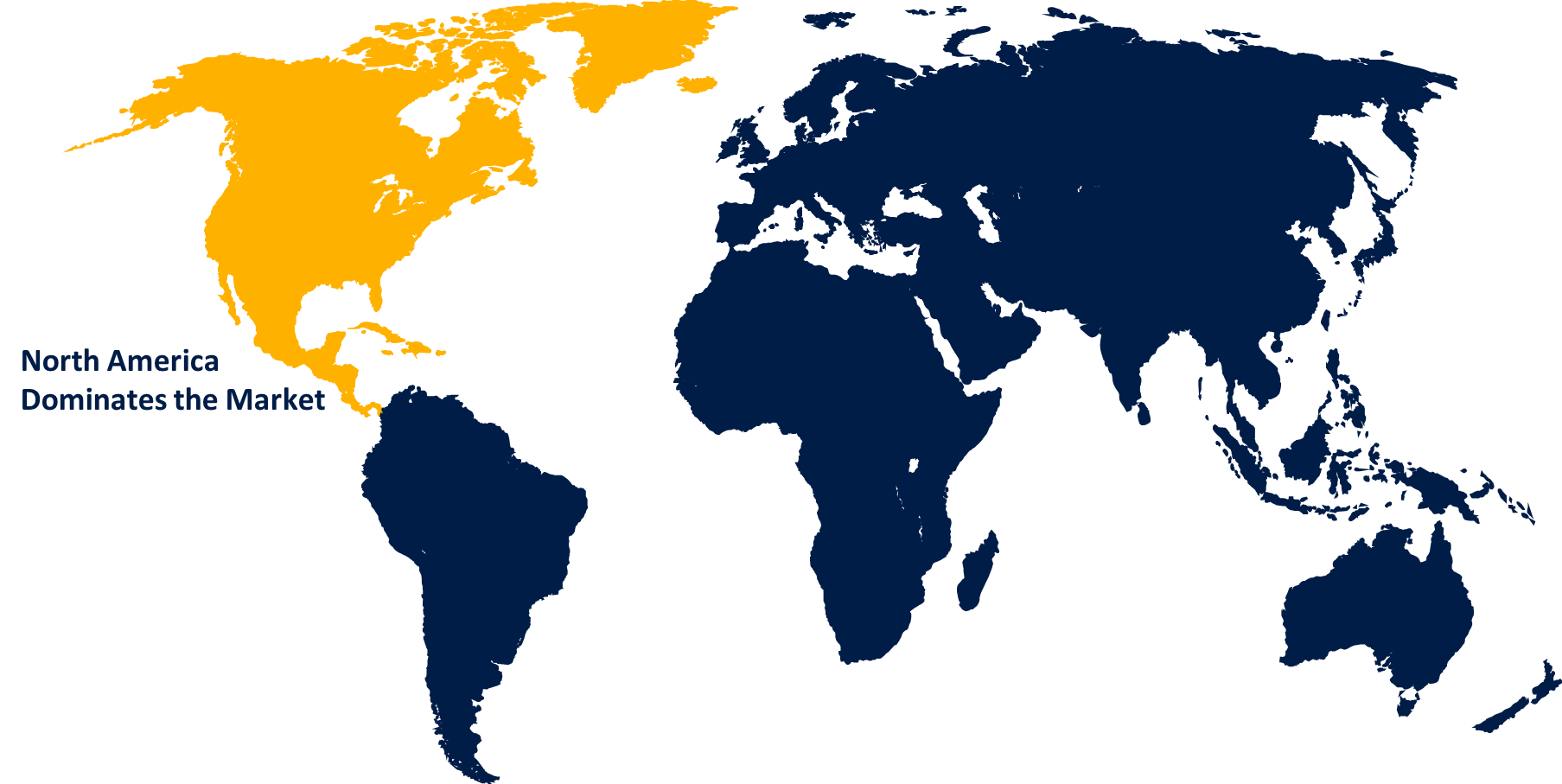Global Pea Protein Market Size, Share, and COVID-19 Impact Analysis, By Product (Isolates, Concentrates, Textured, and Hydrolysates), By Form (Dry and Wet), By Source (Yellow Split Peas and Others), and By Region (North America, Europe, Asia-Pacific, Latin America, Middle East, and Africa), Analysis and Forecast 2023 - 2033
Industry: Food & BeveragesGlobal Pea Protein Market Insights Forecasts to 2033
- The Global Pea Protein Market Size Was Valued at USD 1.98 Billion in 2023
- The Market Size is Growing at a CAGR of 11.48% from 2023 to 2033
- The Worldwide Pea Protein Market Size is Expected to Reach USD 5.87 Billion by 2033
- Europe is Expected to Grow the fastest during the forecast period.

Get more details on this report -
The Global Pea Protein Market Size is Anticipated to Exceed USD 5.87 Billion by 2033, Growing at a CAGR of 11.48% from 2023 to 2033.
Market Overview
Pea protein is a plant-based protein made from yellow peas that is broadly used as a substitute for animal proteins. It is gaining popularity due to its high nutritious value, high concentration of essential amino acids, and suitability for vegan, vegetarian, or allergen-free diets. Pea protein, unlike other plant proteins, is hypoallergenic, making it an excellent choice for people allergic to dairy, soy, or gluten. Pea proteins have low cholesterol and fat content, which promotes muscle growth, aids weight management, and improves heart health. Pea protein is also more digestible than other plant-based proteins; it reduces the risk of bloating and digestive discomfort. Pea protein is generally found in protein powders, energy bars, and plant-based meat alternatives, making it an adaptable source of protein for various diets. As more people switch to plant-based diets for health, environmental, or ethical reasons, pea protein is becoming a staple in many food products. Its sustainable cultivation and production make it an appealing option for environmentally conscious consumers, contributing to its rising global protein market demand.
Report Coverage
This research report categorizes the market for the global pea protein market based on various segments and regions forecasts revenue growth and analyzes trends in each submarket. The report analyses the key growth drivers, opportunities, and challenges influencing the global pea protein market. Recent market developments and competitive strategies such as expansion, product launch, and development, partnership, merger, and acquisition have been included to draw the competitive landscape in the market. The report strategically identifies and profiles the key market players and analyses their core competencies in each sub-segment of the global pea protein market.
Global Pea Protein Market Report Coverage
| Report Coverage | Details |
|---|---|
| Base Year: | 2023 |
| Market Size in 2023: | USD 1.98 Billion |
| Forecast Period: | 2023 – 2033 |
| Forecast Period CAGR 2023 – 2033 : | 11.48% |
| 023 – 2033 Value Projection: | USD 5.87 Billion |
| Historical Data for: | 2019-2022 |
| No. of Pages: | 215 |
| Tables, Charts & Figures: | 120 |
| Segments covered: | By Product, By Form, By Source, By Region |
| Companies covered:: | Burcon, Roquette Frères, The Scoular Company, Louis Dreyfus Company (LDC), COSUCRA., Nutri-Pea, Shandong Jianyuan Group, SOTEXPRO, Ingredion., Axiom Foods, Inc., FENCHEM, Martin & Pleasance, The Green Labs LLC., BurconNutrascience Corp, CosucraGroupeWarcoing, Others |
| Pitfalls & Challenges: | COVID-19 Empact, Challenge, Future, Growth, & Analysis |
Get more details on this report -
Driving Factors
Increasing consumer awareness of the nutritional
There has been a significant rise in the popularity of plant-based foods globally, with various new products hitting the market, ranging from bakery items and pastries to pizza, lattes, and vegan burgers. Pea protein powder has become a widespread component in protein shakes, smoothies, and energy drinks due to its ability to boost protein content. It is naturally vegan and hypoallergenic, making it suitable for various dietary preferences. Pea protein is high in iron and high-quality protein, and it is thought to promote muscle growth, help with weight loss, and improve heart health. According to studies, protein derived from peas, mostly yellow peas, can help lower cholesterol and blood pressure levels while not putting strain on the kidneys. These health benefits are expected to drive the growth of the global pea protein market.
Restraining Factors
Increased Raw Material Cost
The industry is dealing with the consequences of the peas shortage. The significant price increases are expected to result in higher costs for customers. As a result, the market’s growth is constrained by an unstable supply of raw materials and rising prices.
Market Segmentation
The global pea protein market share is classified into product, form, and source.
- The isolates segment is expected to hold the largest share of the global pea protein market during the forecast period.
Based on the product, the global pea protein market is categorized into isolates, concentrates, textured, and hydrolysates. Among these, the isolates segment is expected to hold the largest share of the global pea protein market during the forecast period. Pea protein isolates are high in essential amino acids, specifically branched-chain amino acids (BCAAs), which are required for muscle growth and recovery. They also contain high levels of iron and are easily digestible, making them an excellent choice for health-conscious consumers. The growing emphasis on fitness, weight management, and overall health raises the demand for high-quality protein sources like pea protein isolates. Furthermore, the benefits to heart health, muscle maintenance, and growth pique consumer interest.
- The dry segment is expected to grow at the fastest CAGR during the forecast period.
Based on the form, the global pea protein market is categorized into dry and wet. Among these, the dry segment is expected to grow at the fastest CAGR during the forecast period. The dry processing methods used to produce pea protein concentrates and isolates result in a more concentrated protein product, making them ideal for manufacturers and consumers looking for efficient protein sources. This stability allows for easy storage and transportation, making it suitable for a variety of applications such as protein powders, snack bars, and meal replacements. The convenience of dry pea protein is in line with modern consumers' busy lifestyles, which require quick and easy ways to meet their nutritional needs.
The yellow split peas segment is expected to grow at the fastest CAGR during the forecast period.
Based on the source, the global pea protein market is categorized into yellow split peas and others. Among these, the yellow split peas segment is expected to grow at the fastest CAGR during the forecast period. Their high protein content and essential nutrients, such as fiber, vitamins, and minerals, make them ideal for pea protein extraction. Additionally, they are widely distributed, ensuring a consistent supply. Yellow split peas have favorable functional properties and a neutral flavor, making them suitable for a variety of food applications. Yellow split peas are popular in the market because consumers are familiar with and accept them.
Regional Segment Analysis of the Global Pea Protein Market
- North America (U.S., Canada, Mexico)
- Europe (Germany, France, U.K., Italy, Spain, Rest of Europe)
- Asia-Pacific (China, Japan, India, Rest of APAC)
- South America (Brazil and the Rest of South America)
- The Middle East and Africa (UAE, South Africa, Rest of MEA)
North America is projected to hold the largest share of the global pea protein market over the forecast period.

Get more details on this report -
North America is projected to hold the largest share of the global pea protein market over the forecast period. Increasing demand for gluten-free products, growing concerns about cardiovascular diseases (CVDs) caused by red meat consumption, and strong growth in the sports nutrition industry in North America are expected to drive the regional market over the forecast period. The protein (pea) market in North America is expected to grow significantly over the forecast period, owing to increased consumption of energy bars, cold cereals, and snacks.
Europe is expected to grow at the fastest CAGR growth of the global pea protein market during the forecast period. Various factors include an increased emphasis on healthy living, a growing trend toward preventive health care, and rising demand for plant-based protein ingredients from European countries such as the United Kingdom and Germany. Furthermore, the rapid market growth in Spain, France, Belarus, Russia, and Turkey as a result of increased domestic consumption of nutritionally enhanced powders and dietary soups is expected to benefit the overall plant protein industry.
Competitive Analysis:
The report offers the appropriate analysis of the key organizations/companies involved within the global pea protein market along with a comparative evaluation primarily based on their product offering, business overviews, geographic presence, enterprise strategies, segment market share, and SWOT analysis. The report also provides an elaborative analysis focusing on the current news and developments of the companies, which includes product development, innovations, joint ventures, partnerships, mergers & acquisitions, strategic alliances, and others. This allows for the evaluation of the overall competition within the market.
List of Key Companies
- Burcon
- Roquette Frères
- The Scoular Company
- Louis Dreyfus Company (LDC)
- COSUCRA.
- Nutri-Pea
- Shandong Jianyuan Group
- SOTEXPRO
- Ingredion.
- Axiom Foods, Inc.
- FENCHEM
- Martin & Pleasance
- The Green Labs LLC.
- BurconNutrascience Corp
- CosucraGroupeWarcoing
- Others
Key Market Developments
- In February 2024, Roquette Freres expanded its NUTRALYS line by introducing four multifunctional pea protein isolates to improve the taste and texture of plant-based products. The four new products are NUTRALYS Pea F853M (isolate), NUTRALYS T PEA 700 M (textured), NUTRALYS H 85 (hydrolysate), and NUTRALYS Pea 700 FL (textured).
- In February 2024, Louis Dreyfus Company (LDC) announced the construction of a pea protein isolate production plant for its Plant Proteins business at its existing industrial complex in Yorkton, Saskatchewan, Canada.
Key Target Audience
- Market Players
- Investors
- End-users
- Government Authorities
- Consulting And Research Firm
- Venture capitalists
- Value-Added Resellers (VARs)
Market Segment
This study forecasts revenue at global, regional, and country levels from 2020 to 2033. Spherical Insights has segmented the global pea protein market based on the below-mentioned segments:
Global Pea Protein Market, By Product
- Isolates
- Concentrates
- Textured
- Hydrolysates
Global Pea Protein Market, By Form
- Dry
- Wet
Global Pea Protein Market, By Source
- Yellow Split Peas
- Others
Global Pea Protein Market, By Regional
- North America
- US
- Canada
- Mexico
- Europe
- Germany
- UK
- France
- Italy
- Spain
- Russia
- Rest of Europe
- Asia Pacific
- China
- Japan
- India
- South Korea
- Australia
- Rest of Asia Pacific
- South America
- Brazil
- Argentina
- Rest of South America
- Middle East & Africa
- UAE
- Saudi Arabia
- Qatar
- South Africa
- Rest of the Middle East & Africa
Frequently Asked Questions (FAQ)
-
1.What is the CAGR of the global pea protein market over the forecast period?The Global Pea Protein Market Size is Expected to Grow from USD 1.98 Billion in 2023 to USD 5.87 Billion by 2033, at a CAGR of 11.48% during the forecast period 2023-2033.
-
2.Which region is expected to hold the highest share in the global pea protein market?North America is projected to hold the largest share of the global pea protein market over the forecast period.
-
3.Who are the top key players in the pea protein market?The top key players in the global pea protein market are Burcon, Roquette Frères, The Scoular Company, Louis Dreyfus Company (LDC), COSUCRA., Nutri-Pea, Shandong Jianyuan Group, SOTEXPRO, Ingredion., Axiom Foods, Inc., FENCHEM, Martin & Pleasance, The Green Labs LLC., BurconNutrascience Corp, CosucraGroupeWarcoing, Others.
Need help to buy this report?